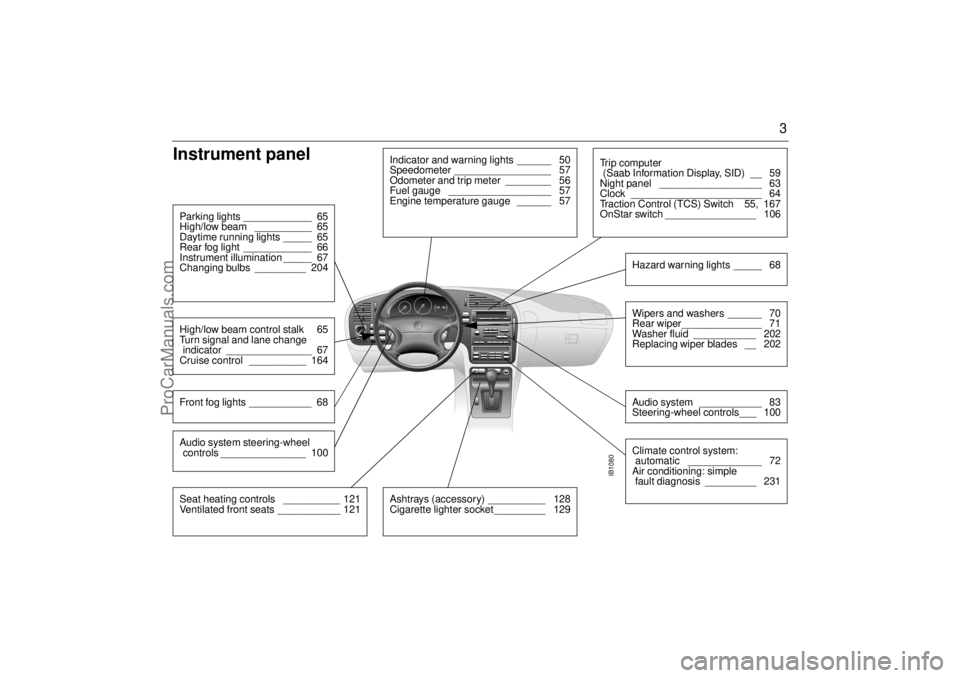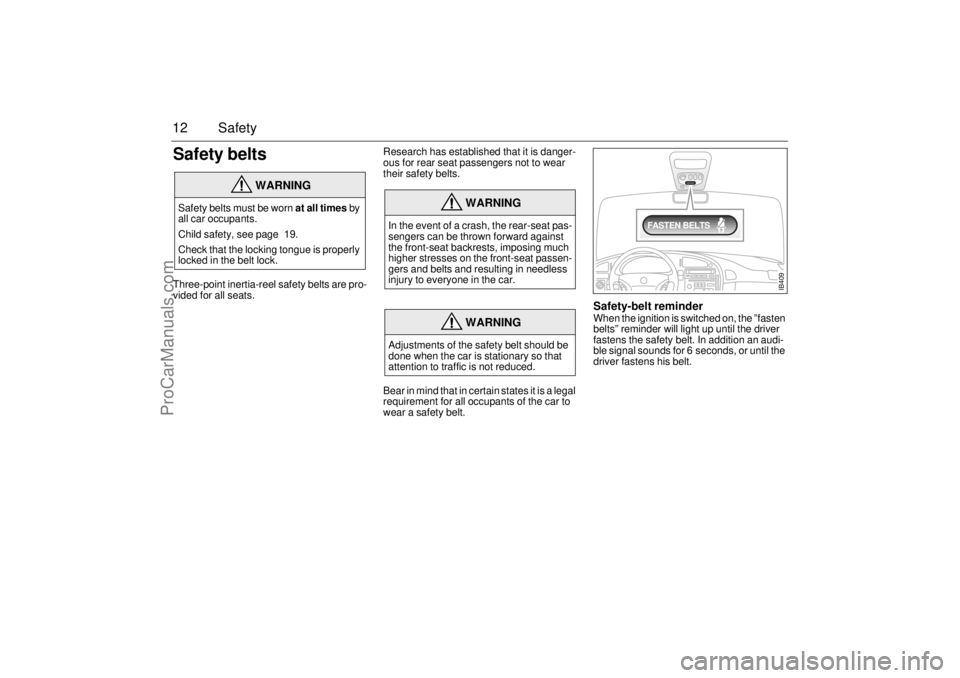warning light SAAB 9-5 2002 Owners Manual
[x] Cancel search | Manufacturer: SAAB, Model Year: 2002, Model line: 9-5, Model: SAAB 9-5 2002Pages: 272, PDF Size: 16.26 MB
Page 3 of 272

3
Instrument panel
IB1080
Indicator and warning lights ______ 50
Speedometer _________________ 57
Odometer and trip meter ________ 56
Fuel gauge __________________ 57
Engine temperature gauge ______ 57
Parking lights ____________ 65
High/low beam __________ 65
Daytime running lights _____ 65
Rear fog light ____________ 66
Instrument illumination _____ 67
Changing bulbs _________ 204High/low beam control stalk 65
Turn signal and lane change
indicator _______________ 67
Cruise control __________ 164Front fog lights ___________ 68
Ashtrays (accessory) __________ 128
Cigarette lighter socket _________ 129
Tr i p c o m p u t e r
(Saab Information Display, SID) __ 59
Night panel __________________ 63
Clock _______________________ 64
Traction Control (TCS) Switch 55, 167
OnStar switch ________________ 106
Wipers and washers ______ 70
Rear wiper ______________ 71
Washer fluid ___________ 202
Replacing wiper blades __ 202Audio system ___________ 83
Steering-wheel controls___ 100Hazard warning lights _____ 68Climate control system:
automatic _____________ 72
Air conditioning: simple
fault diagnosis _________ 231
Seat heating controls __________ 121
Ventilated front seats ___________ 121Audio system steering-wheel
controls _______________ 100
ProCarManuals.com
Page 12 of 272

12 SafetySafety belts Three-point inertia-reel safety belts are pro-
vided for all seats. Research has established that it is danger-
ous for rear seat passengers not to wear
their safety belts.
Bear in mind that in certain states it is a legal
requirement for all occupants of the car to
wear a safety belt.
Safety-belt reminderWhen the ignition is switched on, the ”fasten
belts” reminder will light up until the driver
fastens the safety belt. In addition an audi-
ble signal sounds for 6 seconds, or until the
driver fastens his belt.
WARNING
Safety belts must be worn at all times by
all car occupants.
Child safety, see page 19.
Check that the locking tongue is properly
locked in the belt lock.
WARNING
In the event of a crash, the rear-seat pas-
sengers can be thrown forward against
the front-seat backrests, imposing much
higher stresses on the front-seat passen-
gers and belts and resulting in needless
injury to everyone in the car.
WARNING
Adjustments of the safety belt should be
done when the car is stationary so that
attention to traffic is not reduced.
IB409
FASTEN BELTS
ProCarManuals.com
Page 29 of 272

29 Safety
Airbag (Supplemental
Restraint System
"SRS") The supplementary restraint system (SRS)
comprises an airbag in the steering wheel,
a front passenger airbag and side airbags in
the front seats.
The system supplements the protection
provided by the safety belts to further
enhance the safety of the occupants.
If a fault is detected in the SRS, the
AIR BAG warning light on the main instru-
ment panel will come on (see pages 52 and
34). When the system is triggered by impact of a
frontal crash, the airbags in the steering
wheel and passenger side of the dash board
are inflated, after which they deflate through
vents in the back of the bags.
The front airbags are inflated in two stages.
The first stage process is a less severe,
softer inflation of the airbag. This stage is
used in lower force crashes, or if the seat is
positioned close to the steering wheel or
dashboard. The second stage process is a
more forceful and quicker inflation of the air-
bag. This stage is used in more severe
crashes and/or when the seat adjustment is
back a significant distance from the steering
wheel or dashboard.
The entire process takes less than
0.1 second – literally, faster than the blink-
ing of an eye.
These airbags are triggered only by moder-
ate to severe frontal or near-frontal crashes.
They will not be activated by minor front-end
impacts, rear-end or side impacts, or by the
car rolling over.
WARNING
To reduce risk of injury:
Always wear your safety belt.
Always adjust your seat so that you
are as far back as possible but still
able to reach the steering wheel and
controls comfortably.
Children 12 and under or shorter than
140 cm (55 inches) should always
travel in the rear as the vehicle is
equipped with an airbag on the pas-
senger side.
WARNING
Even if the car is equipped with SRS
(airbag), safety belts must still always
be worn by all occupants.
Note that because an airbag inflates
and deflates extremely rapidly, it will
not provide protection against a
second impact occurring in the same
incident. Always use your safety belt.
Always sit with the whole of your back
in contact with the backrest of the seat,
and with your seat as far back as is
practical. This is to reduce the risk of
injury from contact with the backrest of
the seat when the airbag inflates and
also because the airbag needs space
in which to inflate.
Never attach anything to the steering
wheel or passenger side of the instru-
ment panel, as this could result in
injury if the airbag should inflate. The
same applies to anything you might
have in your mouth, such as a pipe, for
instance.
Some components of the airbag will
be warm for a short time. In some cir-
cumstances the airbag can cause
minor burns or abrasions to the body
when the airbag inflates/deflates.
ProCarManuals.com
Page 30 of 272

30 Safety Never rest your hands or forearms on
the steering-wheel center padding.
If the AIR BAG warning light remains
on after the car has been started or
comes on while you are driving, have
the car checked immediately by an
authorized Saab dealer. The warning
light could signify that the airbags may
not inflate in a crash, or they could
even inflate without a crash. See
page. 52.
IB417Moment of impact.
Sensor detects decel-
eration and sends a
signal via the control
module to a gas gen-
erator that inflates the
airbag.
The inflating airbag
cushions the driver.
Airbag now fully
inflated.
The airbag starts to
deflate.
IB419
Inflated airbag (driver side) Inflation and deflation together take less than
0.1 second.
ProCarManuals.com
Page 32 of 272

32 SafetyFront passenger seat The airbags are interconnected and have a
common warning light. The passenger
airbag module is housed in the fascia above
the glove compartment and is marked ”SRS
AIRBAG”.
Both airbags will be inflated in the event of a
moderate to severe frontal, or near-frontal
crash, even if the passenger seat is unoccu-
pied.
Side airbags Side airbags are housed inside the back-
rests of the front seats and are designed to
protect the driver and front passenger in the
event of a side impact.
In a side impact, only the airbag on that side
will be activated, and only then if certain pre-
determined conditions are met such as the
force and angle of the impact, the speed of
the car on impact, and at which point on the
car’s side the impact occurs.
The sensors, which are fitted in the front
doors, sense the rise in pressure caused by
the door panel being pressed in during an
WARNING
Never secure a rear-facing child seat in
the right front seat of a car equipped with
a passenger airbag. Inflation of the airbag
in the event of a crash could seriously
injure or kill a child.
WARNING Children 12 and
under can be killed by
the airbag
The back seat is the
safest place for children
Never allow a child to stand in front of
the seat or to sit on the lap of a
front-seat passenger. Serious injury or
death could result if the airbag is
inflated in a crash.
Never place anything on the dash or in
front of the seat as, in addition to being
a hazard to passengers, this could
interfere with the function of the airbag
in the event of a crash. The same
applies to the mounting of accessories
on the dash.
Keep feet on the floor - never put feet
up on the fascia, on the seat or out of
the window.
Do not carry anything in your lap.
IB420
Passenger airbag and driver’s airbag both
inflated
ProCarManuals.com
Page 34 of 272

34 Safety
AIR BAG warning light
SRS servicingThe SRS must be inspected as part of the
normal service program but otherwise may
be regarded as maintenance-free.
Scrapping or working on airbags
and belt pretensioners
WARNING
If the air bag readiness light stays on
after you start your vehicle, it means
the air bag system may not be working
properly.
The air bags in your vehicle may not
inflate in a crash, or they could even
inflate without a crash.
To help avoid injury to yourself or oth-
ers, have your vehicle serviced right
away if the air bag readiness light
stays on after you start your vehicle.
WARNING
Under no circumstances may any
modifications be made that affect the
steering wheel or the airbag’s electri-
cal circuitry.
Before starting any welding work on
the car, always disconnect the nega-
tive (–) battery lead and cover the con-
ductor.
Airbags and belt pretensioners must
be deployed under controlled condi-
tions before the car is scrapped or any
of the system’s components are
removed. Airbags or belt pretension-
ers that have been deployed as a
result of a crash must be replaced by
new ones.
Airbag-system components must
never be transferred for use in another
vehicle.
All work involving the scrapping or
replacement of airbags or belt preten-
sioners must only be carried out by
knowledgeable personnel.
IB1707
Side airbag components 1 Side airbag
2 Sensor
3 Moisture barrier
4 Text on seat
ProCarManuals.com
Page 36 of 272

36 SafetyAre the smoke and fumes given off when the
airbag operates at all harmful? Most people who have remained in a car
with little or no ventilation for several min-
utes complained only of minor irritation of
the throat and eyes. Avoid as far as possible
getting dust on your skin as there is a risk of
skin irritation.
If this trouble persists, you should consult a
doctor.
If you suffer from asthma, the incident may
bring on an attack, in which case you should
follow the normal procedure advised by
your doctor. It is advisable to consult a
doctor afterwards.
What should I do if the AIR-BAG warning
light comes on? If the warning light is on, it means that a fault
has been detected in the system. The
airbag cannot be relied on to operate as
intended and it might even be activated
erroneously. You should therefore take the
car to an authorized Saab dealer as soon as
possible.
WARNING
When an airbag is inflated there is dust in
the air.
Because the dust sometimes contains
particles of a substance resembling dish
detergent, the following precautions
should be taken:
As soon as possible, wash any
exposed skin using a mild soap and
water.
If there is irritation of the eyes, flush
them liberally with clean water for at
least 20 minutes.
WARNING
To reduce the risk of head injuries in the
event of a crash, the headliner and pillar
trims incorporate energy absorbing mate-
rial. These areas must not be modified in
any way. Work on these areas must only
be carried out at an authorized Saab
dealer.
ProCarManuals.com
Page 39 of 272

39 Security
To check the number of keys that are pro-
grammed for the car; see page 47.Electronic starting interlock
(immobilizer)Each time the key is removed from the igni-
tion, the electronic starting interlock is acti-
vated and the car is thus immobilized, see
also page 44.Reprogramming lock system
functionsCertain lock system functions can be repro-
grammed by your authorized Saab work-
shop; see page 259.
Locking/unlocking the car When the car is locked and unlocked the
theft alarm is also affected.
Remote locking (1)
Press once on the control: all doors
locked.
The hazard warning lights will flash once
and the horn chirps once to confirm.
The tailgate cannot be opened now from
inside using the switch on the driver´s door.
Remote unlocking (2)
Press once on the control: the driver´s
door is unlocked. Press a second time to
unlock the rest of the doors.
The hazard warning lights will flash twice
and the horn chirps twice to confirm.
If remote unlocking should fail to work
Unlock the driver’s door with the key. To
silence the alarm, insert the key into the igni-
tion switch and turn it to the ON position.
The car can now be started. Contact your
local Saab dealer to have the system
checked and rectified.
NOTEThe key contains delicate electronics.
Do not expose it to water.
Avoid rough handling.
Do not place the key where it may be
subjected to high temperatures, e.g.
on the instrument panel.
The key may malfunction if it becomes
very cold. Warm it in your hands for a
couple of minutes.
Never open the key except to change the
battery. For changing the battery, see
page 40.
WARNING
The remote control also works from inside
the car. Therefore, hold the key in such a
way that the buttons are not unintention-
ally pressed when the key is turned, or
inserted or removed from the ignition
switch.
Otherwise, the doors may be unintention-
ally locked or the tailgate unlocked. On
Sedan models, the trunk may even be
opened.
IB1557
Locking/unlocking by remote control.1To lock
2 To unlock
ProCarManuals.com
Page 40 of 272

40 SecurityLocking by key (1)
When the car is locked and unlocked the
theft alarm is also affected.
Turn the key clockwise: all doors locked.
The trunk lid/tailgate cannot be opened now
from inside using the switch on the driver’s
door.
Unlocking by key (2)
Turn the key counterclockwise once: the
driver´s door will unlock.
Turn the key counterclockwise twice: all
doors, but not trunk lid/tailgate, unlocked. The central locking can also be operated
from inside the car by means of the
switch on the center console.
To lock all doors: press the symbol side of
the switch once.
To unlock the driver´s door: press the
switch once.
To unlock all doors: press the switch
twice.
This switch is inoperative when the car is
locked from the outside.
The interior locking buttons on each door
affect only the respective door.If the car is left with the doors open, the inte-
rior lighting and the courtesy lights in the
doors will be switched off automatically after
20 minutes, to prevent a flat battery. In such
cases the electrically operated seats will not
function.
Changing the key batteryWhen the battery voltage in the key falls
below a predetermined level the SID will
issue the following message: ”REPLACE
KEY BATTERY”. Press the CLEAR button
on the SID to acknowledge this message.
You must then replace the battery without
delay to avoid malfunctions. The life of the
battery is normally 4 years.Contact a Saab
dealer to have the battery replaced.
WARNING
Having the doors locked when you are
driving will reduce the likelihood of:
Passengers, especially children,
opening doors and falling out of the
car.
Intruders entering the car when it is
moving slowly or stopped.
Being thrown out of the car in a crash.
IB451
Switch for operation of central locking
IB1555
2
1
Locking/unlocking by key1To lock
2 To unlock
ProCarManuals.com
Page 45 of 272

45 Security
Alarm signals When the car alarm is armed, it will be trig-
gered if any door, or the trunk lid or hood, is
opened or if a window is broken.
The alarm will also be triggered if an attempt
is made to bypass or short-circuit the igni-
tion switch, or to disconnect the battery.
If the alarm is triggered, the following alarm
signals will be set off:
Flashing of hazard warning lights for five
minutes.
Siren wailing for 30 seconds.
The alarm signals will stop if the alarm is
deactivated (car unlocked) during the alarm
period.
The alarm siren has a long-life battery
(approx. 10 years), see ”SERVICE THEFT
ALARM”, on page 47. When the battery
goes dead, the siren must be replaced: it is
not possible to change the batteries.
Panic-functionIn the car alarm system is a function called
"Panic-function".
To activate panic function:
Push and hold one of the buttons on the
key for 2 seconds. Or, if you are sitting
inside the car, push the LOCK-switch on
the center console for 2 seconds.
These actions will trigger the alarm (hazard
warning lights and siren).
To deactivate panic function:
Push one of the buttons on the key, push
the LOCK-switch in the center console,
turn the key in the driver´s door or turn the
ignition to ON.
When the panic-function is activated the car
will be locked/unlocked depending upon
which button was pushed.
When the ignition is ON the panic-function
cannot be activated.
NOTE It is possible to inadvertently deacti-
vate the car alarm and at the same
time unlock the car, if the button on the
key is pressed by mistake when the
car is still within its range.
When locking the car by remote con-
trol in extremely cold weather, it is
advisable to check that the lock
system has operated properly. To do
so, check that the interior locking but-
tons are all down.
If not, unlock and relock the car again.
ProCarManuals.com